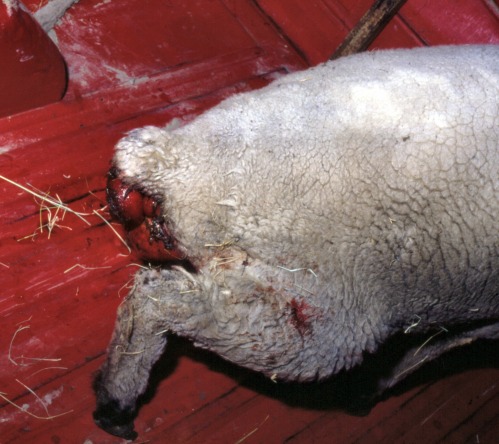The Visual Guide to
Ovine Reproduction
- Prolapsed Vagina
- Hydrops Allantois
- Mummification
- Maceration
- Ruptured Prepubic Tendon
- Abdominal Hernia
- Pregnancy Ketosis
- Prolonged Gestation
- Uterine Torsion
Accidents of Gestation: Prolapsed Vagina
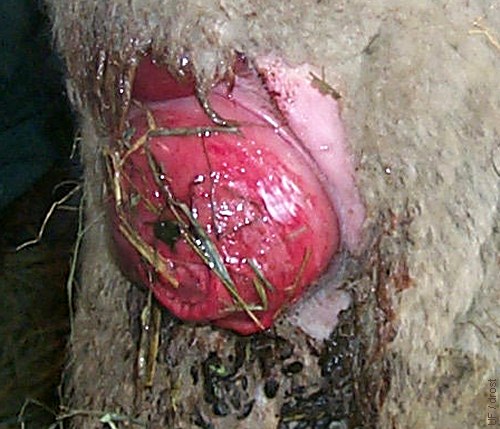
Vaginal Prolapse.
Vaginal prolapse occurs during the latter part of gestation when estrogen concentrations increase leading to relaxation of the pelvic ligaments. At the same time internal abdominal pressure increases with the distension of the uterus.
Smith MC (2006)
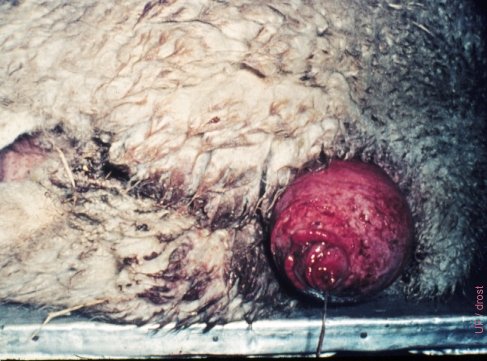
Cervicovaginal Prolapse.
Cervicovaginal prolapse. The external os of the cervix can be seen in the center.
Drost M (1980)
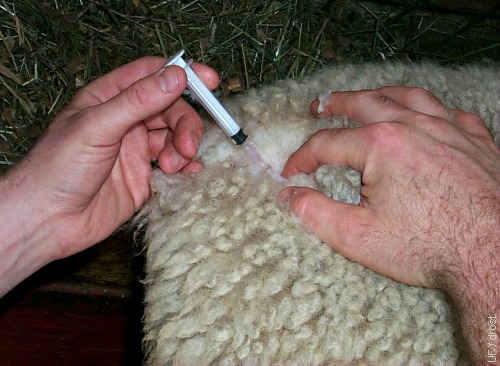
Epidural Anesthesia.
Epidural anesthesia with 2 ml of lidocaine for an adult sheep is administered with a 20 gauge needle angled to pass between the sacrum and the first movable caudal vertebra. Xylazine (0.07 mg/kg) can be added to the lidocaine for prolonged effect and anesthesia as far forward as the flank.
Smith MC (2006)
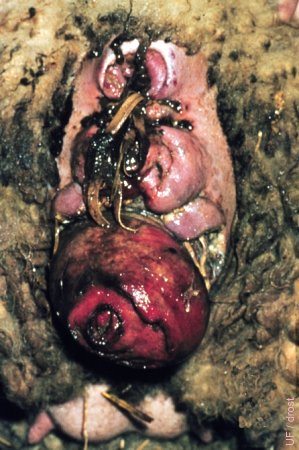
Recurrence of Vaginal Prolapse.
Messy recurrence of a vaginal prolapse. Retention sutures were placed too close to the edges of the lips of the vulva. Sutures should be placed deep and at the line where wool growth begins.
Utrecht (1976)
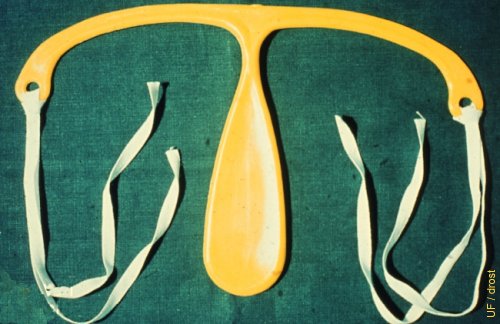
"U-Saver".
Prolapses of the vagina typically occur during the latter part of gestation when estrogen concentrations are high. After replacement of a prolapsed vagina, this device is used to retain the prolapsed mass. The shoehorn like portion is inserted vertically into the vagina and is then turned 90 degrees. The strings are tied laterally to the wool. Ewes can subsequently lamb with the device in place, but should be observed frequently.
Drost M (1970)

Prolapse Paddle in Place.
After replacement of a vaginal prolapse, the mass is kept in place with a prolapse paddle ("U-Saver"). The arms of the plastic device are tied to a simple home-made harness or to the wool near the tuber coxae.
Smith MC (2006)
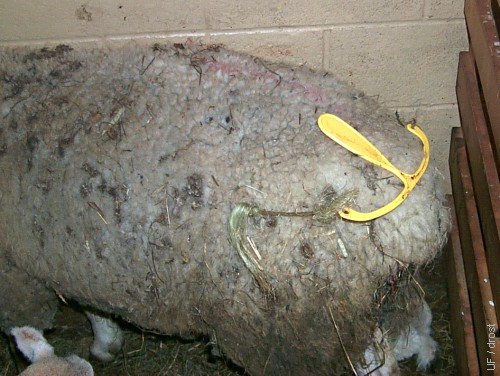
U-Saver Tied to Wool.
This ewe with a prepartum vaginal prolapse has lambed successfully, unattended. The retainer came out at the time of parturition and ended up on top of the sheep. This demonstrates the location of attachment of the strings to the wool.
Smith MC (2006)
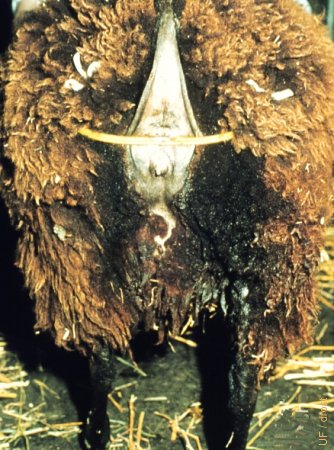
Retention of a Prolapsed Vagina.
After replacement of the vaginal prolapse, the mass is kept in place with a retention device (U-Saver). The arms of the plastic device are tied bilaterally to the wool with umbilical tape. The knots may be seen on top of the wool.
Drost M (1979)
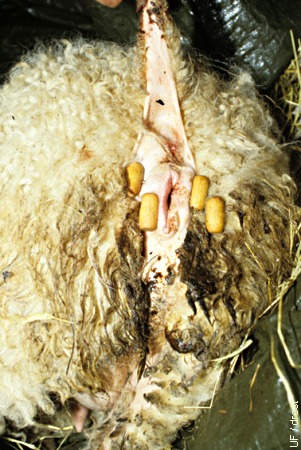
Prolapse Pins in Place.
After replacement of the prolapsed vagina, under epidural anesthesia, toggle pins were placed across the vulva to retain the prolapsed mass. They are readily removable when the ewe goes into labor.
Smith MC (2006)
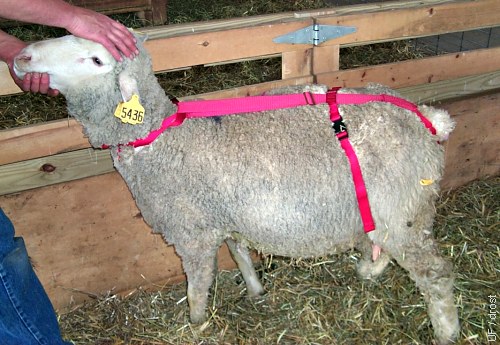
Truss for Prolapsed Vagina.
Commercial truss to retain the prolapsed vagina after replacement. The design would seem to promote choking of the ewe.
Smith MC (2006)
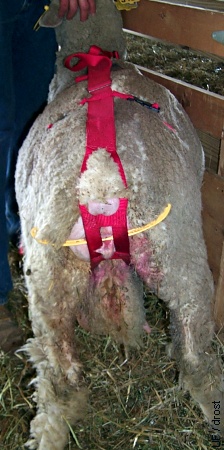
Rear View of Truss.
Commercial truss to retain the prolapsed vagina after replacement, as seen from the rear. The yellow device is a "U-Saver" (prolapse paddle). The owner applied two different methods of prolapse retention, for added security.
Smith MC (2006)

Truss Shown from Behind.
Homemade rope truss in place after replacement of a prolapsed vagina. The sections of rope on each side of the vulva apply external pressure to prevent re-prolapse. No paddle has been used, so there is no stimulus for the ewe to strain, and no risk of damage to the vagina.
Smith MC (2006)
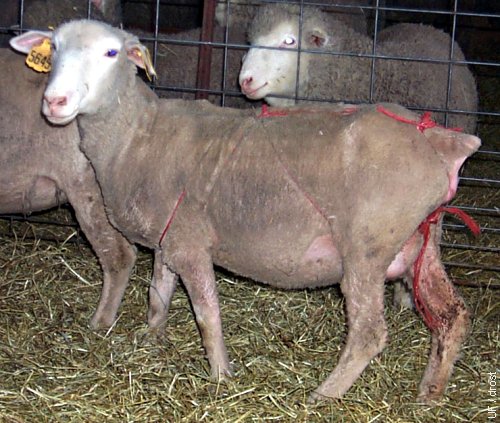
Lateral View of Truss.
Pregnant ewe with homemade truss in place after the prolapsed vagina had been replaced.
Smith MC (2006)
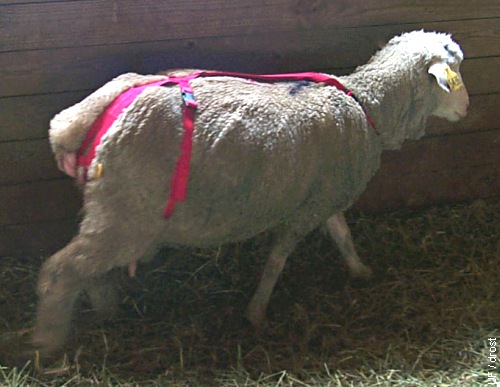
Truss Out of Place.
The harness has shifted and the truss is out of place. For the time being the prolapse has remained in place.
Smith MC (2006)
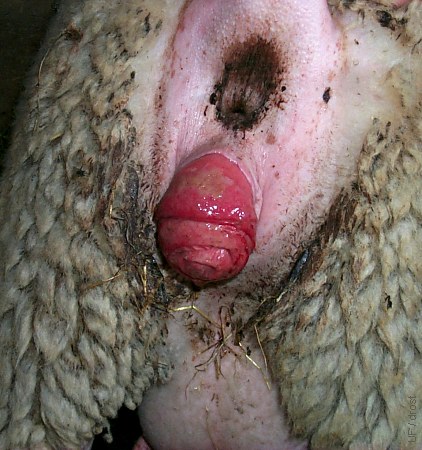
Prolapsed Cervix.
Prepartum prolapse of the cervix is not common. Exposure of the cervix and the vaginal mucosa will lead to drying out, contamination, infection and injury. The prolapse should be replaced and retained to prevent constriction at the time of lambing.
Smith MC (2006)
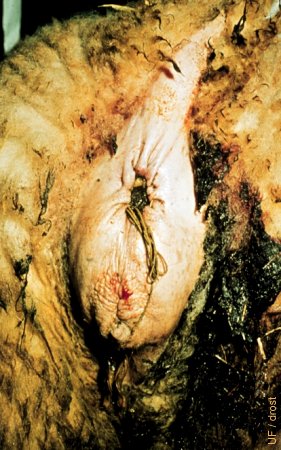
Prolapse of Rectum and Vagina.
Tenesmus led to prolapse of the rectum as well as the vagina. A purse-string suture was placed in the anal sphincter, while the vaginal prolapse was contained with a Buehner stitch. The ewe was not pregnant.
Utrecht (1976)
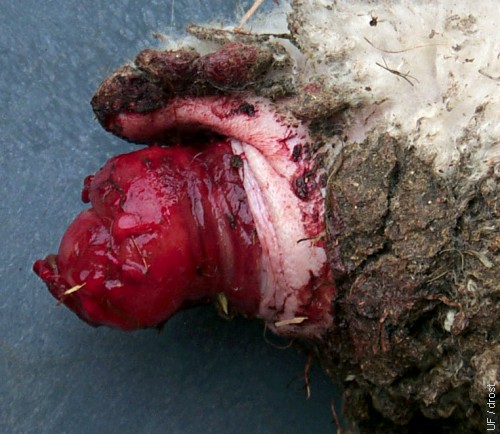
Rectal Prolapse.
Prolapse of the rectum must be differentiated from prolapse of the vagina. Coccidiosis or persistent coughing may have predisposed this ram lamb, which also had previous scours and bronchopneumonia.
Smith MC (2006)

